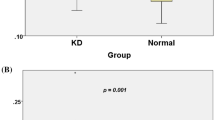Abstract
Forty-one children (15 girls, 26 boys; ages 3.0±2.1 years) with Kawasaki disease (KD) were included in our study. The diameters of a total of 82 coronary arteries (CA), comprising 41 left (LCA) and 41 right (RCA), were computed by two-dimensional echocardiography (2D-Echo). If the diameter of the CA was≥20 mm, it was considered as dilated. The severity of the carditis was evaluated by [99mTc] HMPAO-labeled white blood cell (WBC) heart scans (Tc-WBC) carried out in all cases. On the basis of the results the children were divided into three groups. Group A children had the most severe carditis where the heart uptake was greater than the bone uptake; 11 of 32 (34.3%) of the CA in 16 cases were dilated. Group B had carditis of medium severity where the heart uptake was equal to the bone uptake; 11 of 28 (39.3%) of the CA in 14 cases were dilated. Group C had mild carditis where the heart uptake was less than the bone uptake; 9 of 22 (40.9%) of the CA in 11 cases were dilated. There were no significant differences among the three groups (p=0.87 by a chi-squared test). We conclude that no definite relationship exists between the severity of carditis and the dilatation of the CA in children with KD.
Similar content being viewed by others
References
Fujiwara H, Hamashima Y (1978) Pathology of the heart in Kawasaki disease. Pediatrics 61: 100–107
Kato H, Koike S, Yamamoto M, Ito Y, Yano E (1975) Coronary aneurysms in infants and young children with acute febrile mucocutaneous lymph node syndrome. J Pediatr 86: 892–898
Fujiwara H, Chen C, Fujiwara T, Nishioka K, Kawai C, Hamashima Y (1980) Clinicopathologic study of abnormal Q waves in Kawasaki disease (mucocutaneous lymph node syndrome): an infantile cardiac disease with myocarditis and myocardial infarction. Am J Cardiol. 45: 797–804
Chung JK, Brandt L, Fulton DR, Keridberg MB (1982) Cardiac and coronary arterial involvement in infants and children from New England with mucocutaneous lymph node syndrome (Kawasaki disease). Am J Cardiol 50: 136–139
Hiraishi S, Yashiro K, Oguchi K, Kusano S, Ishii K, Nakazawa K (1981) Clinical course of cardiovascular involvement in the mucocutaneous lymph node syndrome. Am J Cardiol 47: 323–330
Satomi G, Nakimura K, Sakae N, Atsuyoshi T (1984) Systemic visualization of coronary arteries by two-dimensional echocardiography in children and infants: evaluation in Kawasaki's disease and coronary arteriovenous fistulas. Am Heart J 107: 497–504
Maeda T, Yoshida H, Funabashi T, Nakaya S, Takabatake S, Ohno T, Taniguchi N (1983) Subcostal 2-dimensional echocardiographic imaging of peripheral left coronary artery aneurysms in Kawasaki disease. Am J Cardiol 52: 48–52
Yoshida H, Maeda T, Funabashi T, Nakaya S, Takabatake S, Taniguchi N (1982) Subcostal two-dimensional echocardiographic imaging of peripheral right coronary artery in Kawasaki disease. Circulation 65: 956–961
Kao CH, Hsieh KS, Wang YL, et al (1991) Comparison of Tc99m HMPAO labeled white blood cells and Ga-67 citrate scans to detect myocarditis in the acute phase of Kawasaki disease. Nucl Med Commun 12: 951–958
Kao CH, Hsieh KS, Wang YL, et al (1992) Tc-99m HMPAO labeled WBC scan for the detection of myocarditis in different phases of Kawasaki disease. Clin, Nucl Med 3: 185–190
Kao CH, Hsieh KS, Wang YL, et al. (1992) Tc-99m HMPAO WBC imaging to detect carditis and to evaluate the results of high-dose gammaglobulin treatment in Kawasaki disease. Clin Nucl Med 8: 623–626
Kawasaki T (1984) Agreement with the guidelines by the Mucocutanous Lymph Node Syndrome Research Committee (in Japanese). Nippon Shonika Gakkai Zasshi 88: 2693
Kao CH, Wang YL, Wang SJ, Yeh SH (1992) Elution analysis and normal biodistribution of technetium-99m HMPAO labeled white blood cells. J Nucl. Med Technol 20: 224–227
Kawasaki T, Kousaki F (1967) Febrile oculo-oro-cutaneousarco-desquamatous syndrome with or without acute non-suppurative cervical lymphadenitis in infancy and children: clinical observations of 50 cases. Arerugi 16: 172–222
Morens DM, Anderson LJ, Hurwitz ES (1980) National surveillance of Kawasaki disease. Pediatrics 65: 21–25
Kegel SM, Dorsey TJ, Rowen M, Taylor WF (1977) Cardiac death in mucocutaneous lymph node syndrome. Am J Cardiol 40: 282–286
Newburger JW, Takahashi M, Burns JC, et al. (1986) The treatment of Kawasaki syndrome with intravenous gammaglobulin. N Engl J Med 315 341–347
Rose V (1990) Kawasaki syndrome: cardiovascular manifestations. J Rheumatol 17 [Suppl 24]: 11–14
Yoshitake K, Naganuma M, Koike, et al (1980) Electrocardiographic findings in MCLS (in Japanese). Iryo 34: 24–27
Yamamoto S, Umezawa T, Hashiguchi R, Saji T, Matsuo N (1985) Serum, creatine kinase in Kawasaki disease (in Japanese). Shonkia Rinsho 38: 2312–2316
Sfakianakis GN, Al-Sheikh W, Heal A, et al (1982) Comparison of scintigraphy with In-111 leukocytes and Ga-67 in the diagnosis of occult sepsis. J Nucl Med 23: 618–626
Thakur ML, Coleman RE, Welch MS (1977) Indium-111 labeled leukocytes for the localization of abscesses: preparation analysis, tissue distribution and comparison with gallium-67 citrate in dogs. J Lab Clin Med 89: 217–228
Fujiwara H, Kawai C, Kasahara A, Hamashima Y (1979) Impairments of the coronary circulation in children: coronary arterial lesions and clinical findings in patients with Kawasaki disease (in Japanese). Rinsho Kagaku 15: 44–51
Author information
Authors and Affiliations
Rights and permissions
About this article
Cite this article
Kao, C.H., Hsieh, K.S., Chen, Y.C. et al. Relationships between coronary artery dilatation and severity of carditis detected by two-dimensional echocardiography and [99mTc] HMPAO-labeled white blood cell heart scan in children with Kawasaki disease. Pediatr Radiol 24, 41–44 (1994). https://doi.org/10.1007/BF02017659
Received:
Accepted:
Issue Date:
DOI: https://doi.org/10.1007/BF02017659




